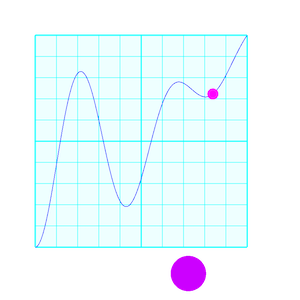
Research
NPM targeted by malware campaign mimicking familiar library names
Socket uncovered npm malware campaign mimicking popular Node.js libraries and packages from other ecosystems; packages steal data and execute remote code.
pixi-easing-graph
Advanced tools
A utility component for viewing easing functions in Pixi.js and react-pixi. The graph includes an animated example and can be highly-customized to fit your needs. Functions are expected to take a single number between (roughly) 0 and 1 and return a number
A utility component for viewing easing functions in Pixi.js and react-pixi. The graph includes an animated example and can be highly-customized to fit your needs. Function are expected to take a single a number between 0 and 1 and return a number between 0 and 1.

Check out the Demo which shows off many of the features and is build with react-pixi.
import {EasingGraph} from "pixi-easing-graph";
const graph = new EasingGraph(func [, options]);
func must be an easing function in the format (x:number) => number where the range of numbers expected for both input and output are between 0.0 and 1.0. (see note below about "Drawing Multiple functions")
options is an object with the following properties and default values:
width - width of the graph - default 250height - height of the graph - default 250style - graph style: "dot", "line", or "fill" - default "dot",clamp - if true, clamps values between the range of 0 and 1 - default falsesteps - number of steps of the function to draw. If the value is NaN, this will equal width - default NaNdotSize - radius of dots when style is "dot" (also used for trails) - default 2lineWidth - thickness of line when style is "line" - default 1background - background color - default 0xffffffforeground - foreground (graph) color - default 0x000000backgroundAlpha - alpha for the background color - default 1.0,fillAlpha - alpha for the foreground color in "fill" mode - default 0.5,gridCount - How many lines in the grid on each axis. If 0, no grid is drawn - default 10gridSubdivisions - when true, the middle and edges of the grid are emphasized - default truegridColor - Color of the grid - default 0xccccccshowMarker - when true, the animation includes a marker dot that follows the graph - default truemarkerColor - color of the marker - default 0xff0000markerSize - size of the marker - default 10markerTrail - when true, the marker leave a trail of dots. If style is dot it won't be drawn. - default falseshowMarker - when true, the animation includes an example animation - default falseexamplePosition - position of the animated example: "bottom", "right" or "both - default "bottom",exampleColor - color of the example animation - default 0x333333exampleSize - size of the example - default 50exampleTrail - when true, the examples leave a trail of dots - default falseshowValues - when true, shows the input and output values in a small text field - default false, fill defaults to foregroundtextStyle - If showValues is true, this is the style used to style the text. You can also include x and y to position the text. Values will be merged with the default. - default { fontSize: 10, x: 5, y: 5, fill: foreground]}duration - Duration of the animation in milliseconds. - default is 2000autoPlay - When true, the animation automatically plays any time draw() is called. - default falseloop - When true, after you play() the animation will loop continuously until you call stop() - default falseTo play an animation of the easing function, use the play() method.
import { EasingGraph } from "pixi-easing-graph";
const graph = new EasingGraph(quad);
stage.addChild(graph);
graph.play();
You can stop animations with stop().
You can adjust the animations by using the marker- & example- properties in options. More animation options coming soon.
It's possible to graph more than one function, for exmaple, if you want to compare two easing funcitons. To do this, replace the func param in the constructor with an array of functions.
const f = (x) => x;
const g = (x) => x * x;
const h = (x) => x * x * x;
const graph = new EasingGraph([f, g, h]);

The first function will be treated as the primary funciton. Only the primary will be animated, show examples, and show text values. All others will only be drawn on the graph. (The ability to draw examples for all functions could be added in the future if needed.)
The functions will be drawn in reverse order so the primary funciton is drawn on top.
By default, the different functions will all use the same styling. To add custom styling to each one, you can create an object for each function...
const graph = new EasingGraph([{f:f, foreground: 0x0000FF}, {f:g, foreground:0xFF0000, {f:h, foreground: 0x00FF00}]);
Any that don't define foreground will use the default value from the options object.
So to summarize, the types that can be passed into the first argument of the constructor are:
EasingFunction | (EasingFunction | {f:EasingFunction, foreground?:number })[]
There is a react-pixi component included with the code.
import { EasingGraphComponent as EasingGraph } from "pixi-easing-graph";
All the options can be passed to this component as props as well as f, x, y.
As a hack, to trigger the animation, you can also set the play property to a different value to trigger the animation.
<button onClick={()=> setPlay(play === 0 ? 1 : 0)}>
dev : start a server to see the demolint : lint the code. You can also do fix to auto-fix.test : test with jest. Also test:coverage and test:watchbuild : bundle the codecommit & release : see belowdeploy: Build the demo code and publish to gh-pagesCode is automatically linted before being committed. I recommend installing the plugins for eslint and prettier in your code editor. You can attempt to fix linting issues with yarn fix.
When ready to commit, please commit using yarn commit to use commitizen for standard format commits.
When ready to release use yarn release with the -r patch|minor|major flag (default without the flag is patch).
You'll then need to publish your changes separately.
You can deploy an updated demo to github pages using yarn deploy
FAQs
A utility component for viewing easing functions in Pixi.js and react-pixi. The graph includes an animated example and can be highly-customized to fit your needs. Functions are expected to take a single number between (roughly) 0 and 1 and return a number
The npm package pixi-easing-graph receives a total of 10 weekly downloads. As such, pixi-easing-graph popularity was classified as not popular.
We found that pixi-easing-graph demonstrated a not healthy version release cadence and project activity because the last version was released a year ago. It has 1 open source maintainer collaborating on the project.
Did you know?

Socket for GitHub automatically highlights issues in each pull request and monitors the health of all your open source dependencies. Discover the contents of your packages and block harmful activity before you install or update your dependencies.

Research
Socket uncovered npm malware campaign mimicking popular Node.js libraries and packages from other ecosystems; packages steal data and execute remote code.

Research
Socket's research uncovers three dangerous Go modules that contain obfuscated disk-wiping malware, threatening complete data loss.

Research
Socket uncovers malicious packages on PyPI using Gmail's SMTP protocol for command and control (C2) to exfiltrate data and execute commands.